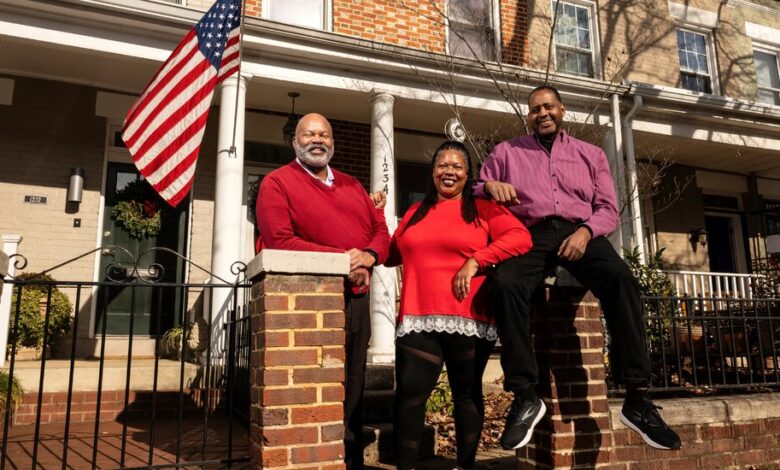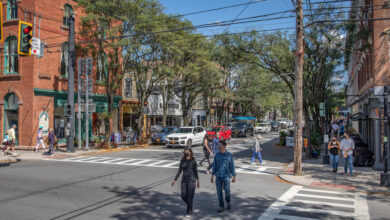In the Face of Racial Discrimination, a D.C. Family Builds a Property Legacy

[ad_1]
Since 1916 and by one name or another, 233 12th St. SE in Washington has been a store — a landmark and meeting place of the Lincoln Park neighborhood.
Christine Campbell, 59, recalls it always being Mott’s Market, even as it changed hands. “Grandmother would send us to the corner store to pick up things she needed for breakfast or dinner,” Ms. Campbell said. “My uncles would talk about playing the numbers at the corner. Mott’s served as a place where information was shared.”
But in the spring of 2022, the Choi family, which had owned the building, including the store, for 40 years, put it up for sale, stoking fears that it would be torn down or turned into something that wouldn’t fit the neighborhood.
Ms. Campbell began talking to her neighbors about how to stop the inevitable. The answer was simple: Buy the building.
That is what Ms. Campbell’s family has done for generations. The Campbell family has built a real estate legacy — starting in Charlotte Hall, Md., with Wesley Plater, Ms. Campbell’s great-grandfather, who worked as a sharecropper and was willed the land he tended, to 2020 when Ms. Campbell and her two brothers bought a bed-and-breakfast in Gettysburg, Pa. As the owners of the Keystone Inn, the Campbell siblings are the first Black hospitality proprietors in the historic home of the Battle of Gettysburg and President Lincoln’s Gettysburg Address.
It’s a legacy that beats the odds: Black people face discrimination in home buying, getting loans and having their houses appraised. Black mortgage applicants are 2.9 percent more likely to have their applications denied, and when they do own, they face a 10 to 13 percent higher tax burden than white homeowners because of assessments, according to the Brookings Institution.
“Owning property has been part of our history and gives us a sense of security, family, and home,” Ms. Campbell said.
Still, buying Mott’s Market proved more difficult than Ms. Campbell and her neighbors thought. They formed the coalition Save Mott’s Market and offered $1 million, but lost to an all-cash buyer willing to pay the full price of $1.25 million.
In the aftermath, the Choi family issued a statement: “We appreciate the showing of support for the store and wish the outcome could’ve been different. Please let them know that it was an honor to serve the community for almost 40 years and that we will always cherish those memories.”
‘Great Grandpop,’ Leroy and Flossie
It was devastating for Ms. Campbell, whose family interest in real estate predates their move into the District, starting with her grandfather whom she calls “Great Grandpop.”
“My great-grandfather wrote his will such that the Maryland property needed to stay in the family as long as any of his children were alive, so they would always have a home to go to,” Ms. Campbell said. “In the meantime, there was a migration of sorts from Southern Maryland to D.C. Through word of mouth, families decided where to settle, tending to move together to certain parts of the city. My family initially settled in this part of D.C.”
Walter Street in Lincoln Park had been designated for Black residents primarily through racially restrictive deed covenants — private contracts aimed at confining D.C.’s growing Black population to certain parts of the city, according to research by Prologue DC LLC, a woman-owned business that maps the history of segregation in the city.
In 1927, Ms. Campbell’s grandparents Flossie Campbell, a beautician, and Leroy Campbell, a postal worker at a time when the mail was delivered on bicycles, saw an ad in The Washington Herald calling for “Reliable Colored Buyers, $100 Cash Will Buy You a Beautiful Home,” according to Plater Campbell, 95, Ms. Campbell’s father.
The Campbells settled on a two-story brick house on Walter Street, barely a mile from the U.S. Capitol and the Supreme Court. The house had been built in 1912 to a design by the 20-year old architect A.E. Landvoigt.
The couple paid $4,000 for the house.
Plater Campbell was born in the house. He recalled the segregation of the neighborhood. “Despite the conditions, we were very happy. The neighborhood was congenial, very personable. The kids put together a baseball team. Most of my friends did very well in life, we kept in touch for years,” he said, in a phone interview. “I’m one of the last ones left.”
His parents then bought a house on Kentucky Avenue SE, two blocks from Walter Street, in 1952, but kept the house on Walter Street to rent to relatives and friends. Over the years, the couple owned four houses in D.C. Ms. Campbell’s Uncle Griffin, who owned a general store in the neighborhood, moved next door to Kentucky Avenue SE in 1952.
Mr. Campbell left his childhood neighborhood when he headed to college. He had wanted to attend the University of Maryland, but it did not accept Black students. Instead, he graduated from Penn State in 1952 with a degree in social agronomy, and three years later, he married Joan Cross, a mathematician. Mr. Campbell worked as a soil scientist with the U.S. Department of Agriculture, rising to become director of the Conservation Planning Division and a member of the Senior Executive Service, one of the first Black members promoted to this rank within the U.S.D.A.
The family moved around the country for Mr. Campbell’s work, and Christine Campbell was born in Fargo, N.D. But the family never sold the Walter Street house, and Plater and Joan moved back in 1984, buying the house from Leroy and Flossie.
Plater and Joan renovated the house, enlisting their son Stephen, who had graduated from Carnegie Mellon University as an architect. It was Stephen’s first official commission.
“It continued a legacy of pride and homeownership of one of the original Black families, my own, on this unique parcel of Washington, D.C., history,” Stephen Campbell, 67, said.
Joan died in February of 2000. In 2007, Plater Campbell, now remarried, moved with his new wife, Faye, to Laurel, Md., and Christine bought the Walter Street house. Stephen bought the Kentucky Street house.
‘Well Played’
The family was already close-knit, but in the thick of the pandemic in 2020, the siblings Christine, Stephen and Patrick realized that they needed one big house where the entire extended family could gather comfortably.
They also wanted a return on their investment so they came up with the idea of buying a bed-and-breakfast, which had long been an ambition of Ms. Campbell.
Christine and her brother Patrick, 57, took a course on running a B&B and hired an inn broker and consultant to help with the search. They set criteria of being within two hours of their respective residences, being in a town that attracted guests, buying something large enough to host family holidays that was on or near stops on the Underground Railroad. “When we walked into the Keystone Inn, we felt it — this was the one. The age of the building, the beautiful woodwork, the location — five blocks from the center of town but a little bit away from things was attractive to us siblings,” Ms. Campbell said.
“We’ve had the last three Thanksgivings at the Inn,” Ms. Campbell said, adding up about 40 or so relatives who were in attendance. “We get a fresh turkey from the local butcher, watch the parade, football and play games. It’s fun and joyous.”
While hard data is impossible to come by, estimates are that perhaps 1 percent of owners of small venues, like inns and bed-and-breakfasts, in the United States are Black.
The Gettysburg house, built in 1913, is nearly 6,000 square feet. The Campbells bought the house for $745,000 and have since invested another $400,000 with renovations, such as gutting and expanding the kitchen, and installing an eight-burner stove.
One renovation was a ramp. “Our mother was in a wheelchair for most of our lives, and we all had memories of going through back doors, freight elevators, or lifting her and her chair up stairwells,” Ms. Campbell said. “It was important to us that every person entered through the main door without feeling put out. One day during the renovations, when Patrick was concerned at the expense of the upgrades, including the ramp, I quietly said, ‘We will dedicate the ramp to Mom.’”
After pausing for a moment, Patrick said, “Well played, sis, well played.”
The next step was actually running an inn and luring guests. Their marketing plan targets family getaways, college reunions and girls’ weekends.
Gettysburg is close to several stops along the Underground Railroad, so they named one of the rooms in the house after Basil Biggs, a free Black farmer and veterinarian in Gettysburg at the time of the Civil War, who was instrumental in reburying the bodies of soldiers killed in Gettysburg. In 1870, after learning the white voters were getting rides to the polls, he used his own wagon to get Black voters there.
‘Grade F’
With yet another property under their belt, the Campbell family is a symbol of generational wealth. Ms. Campbell’s house, the one her grandparents bought in 1927, is worth $1 million, but it is likely the family would have accumulated more wealth if her neighborhood had been whiter through the years.
A Brookings Institution senior fellow, Andre Perry, and co-authors studied 113 metropolitan areas and found that houses in Black neighborhoods are valued at roughly half the price as homes in neighborhoods with no Black residents.
A detailed Federal Housing Administration map published in 1937 shows a Walter Street that was 52 percent owner-occupied, and 63 percent occupied by Black people and other people of color. A separate map created by the agency from the same year assigned scores to each section of the city. Nearly all of Northeast and Southeast D.C., where most of the city’s Black population lived, were given “Grade F,” defined as “declining rapidly into very undesirable sections.”
Yet tellingly, the Works Progress Administration researchers who fanned out across the city collecting data for the detailed 1937 map recorded that no homes on Walter Street needed major repair, and none were unfit for occupancy, defying the blanket statement made by the housing administration.
The Campbell’s Lincoln Park houses increased in value as more white residents moved in. By 2012, their neighborhood’s ZIP code had made a list of the 50 ZIP codes in the United States that had experienced the greatest growth share by a white population.
For Christine Campbell, banding together with all of her neighbors, including white residents, to save Mott’s was important. The inn was in full operation when Mott’s first went up for sale, and she split her time and became a partner in the effort. The residents got some relief when the cash buyer put the store back up for sale.
The group formed a limited liability corporation and obtained more than $450,000 in investment funding, enough to cover a 25 percent down payment and early operating costs. Mott’s Market bought the property in October 2022, paying $1.3 million.
There are now close to 60 investors and a goal to have 400 former and current residents buy a “brick” to benefit the shop.
[ad_2]
Source link






